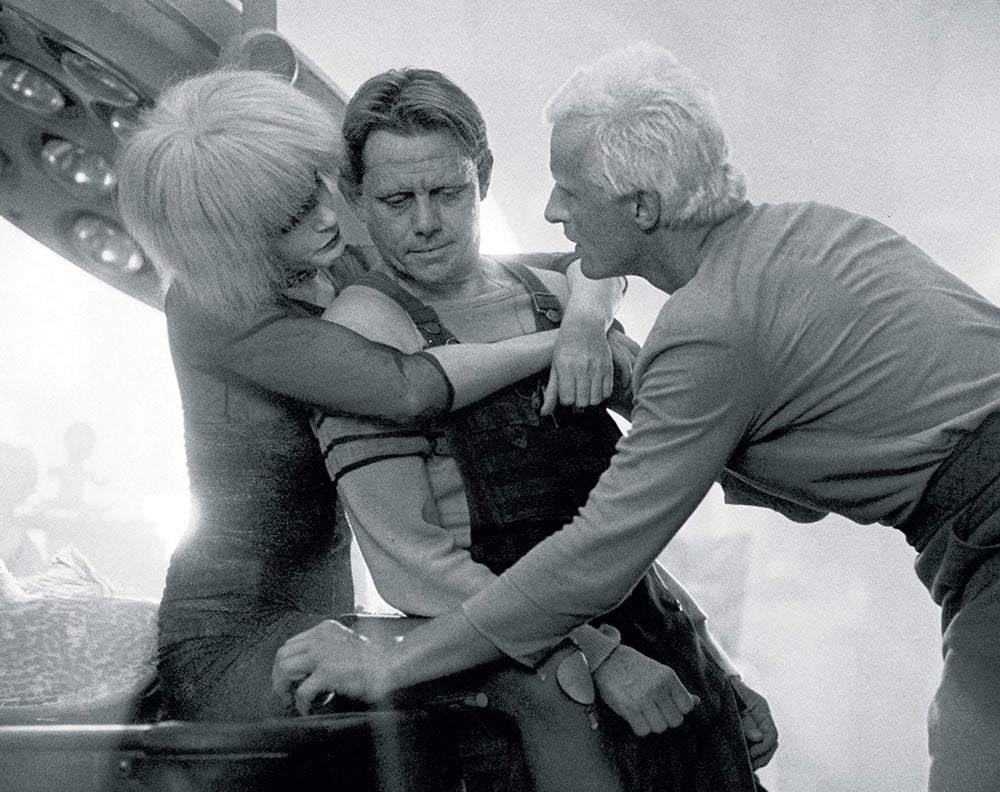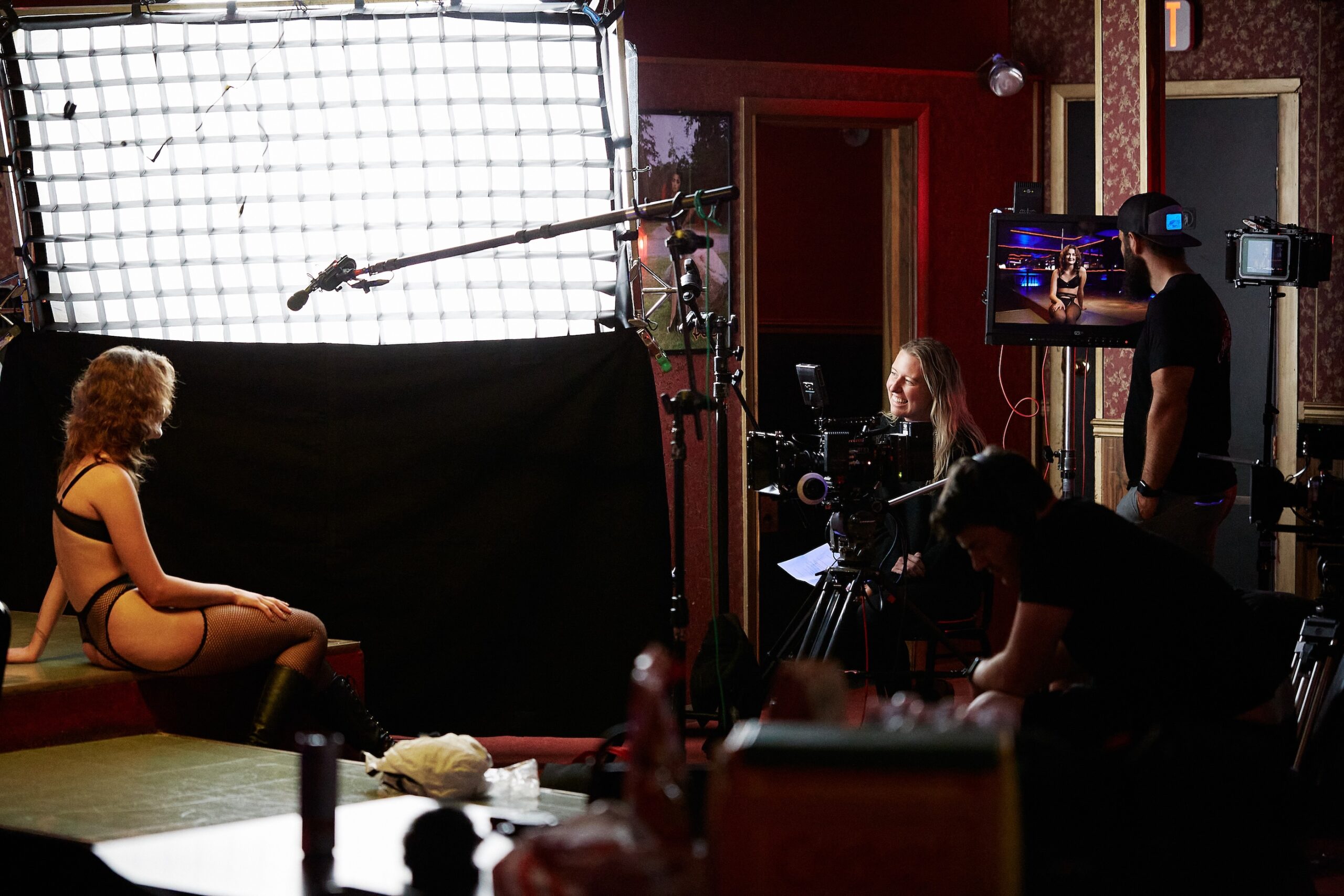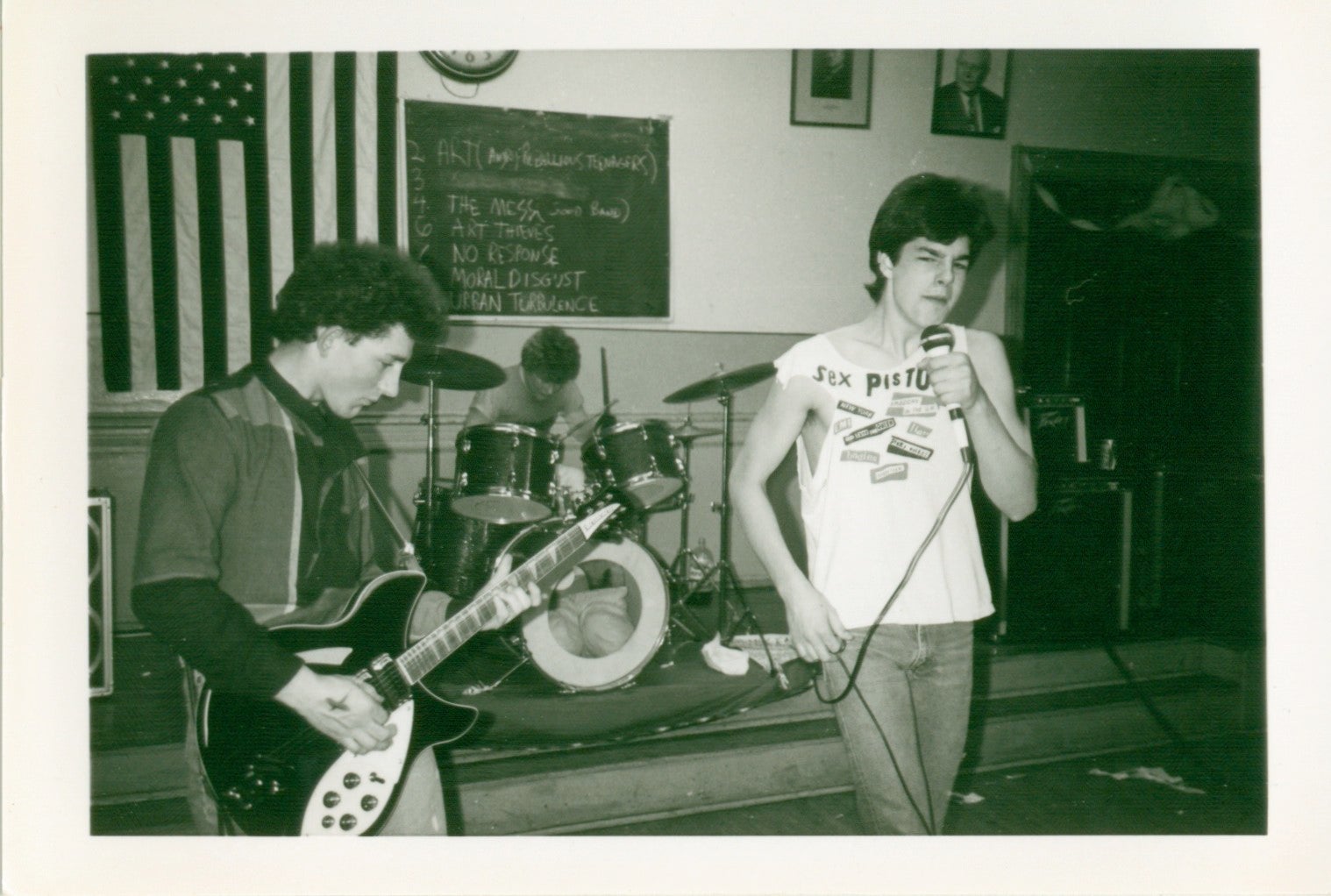“Newhart” and “Deadwood” actor William Sanderson on his transcendent career. Plus, punk journalist and musician Vivien Goldman shares the “her”story of the punk scene and author Nick de Semelyn on the wild and crazy guys who changed Hollywood comedy films forever.
Featured in this Show
-
Journalist Vivien Goldman Explains How Punk Rock Still Sustains, Especially For Women
Vivien Goldman is a pioneering post-punk musician and journalist. She’s also the author of “Revenge of the She-Punks: A Feminist Music History from Poly Styrene to Pussy Riot.” The book covers her lifelong connection with the punk scene and what it was like to be one of the few women covering it in the 1970s.
Goldman told WPR’s “BETA” that her experience covering the developing punk rock scene in England trained her to be a little bit tough. She recalled reading an article in The Guardian back in 2009, which announced the appointment of Krissi Murison as the first woman editor of the New Musical Express in its history.
“And the writer said the few, very few, women who ever wrote there had to have the skin of rhinoceroses,” she said. “And when I read that, I was almost like tears came to my eyes because I realized how much I’d had to stand up for myself. I had one sort of compadre, Caroline Coon, an incredible writer who’s now an increasingly more acclaimed visual artist. It was just us and it wasn’t just that. It was that there was a lot of hostility among even my writers when I was features editor because they liked it the way that it was as a boys’ town. And they were very territorial and they did not want to give up their power.”
Focusing on why punk rock has been, and continues to be, such a liberating force for women, Goldman chose four main themes to explore in her book: Girly Identity: Who Be Me; Money: Are We Our Stuff?; Love/Unlove: Busting Up the Binary; and Protest: Woman the Barricades.
Poly Styrene And X-Ray Spex
One of the most influential icons in the feminist history of punk was Poly Styrene, the lead singer of X-Ray Spex. In her book, Goldman describes her as “an ecstatic, visionary punk godmother.”
“Oh, Poly. She was the first black punk. She was a mixed young woman. Her father was Somalian, and quite orthodox religious Muslim and her mother was sort of Scottish, Irish, English, sort of Celtic, Anglo-Celtic,” Goldman said. “She was a woman on the edge because really at that time, there’s been an incredible rise in the number of mixed people, you know, with parents of different races and colors and so on. It’s now a huge constituency, ever-growing and ever more influential. But at the time, it was, I’m not joking, it was sort of fairly rare. It wasn’t as common as it is now.”
It was Styrene’s struggle with her own biracial identity that inspired the X-Ray Spex song, “Identity,” which was released in 1978.
“It was a clarion call,” Goldman said.
“Now we’re living in the days of an identity industry, aren’t we?” Goldman said. “It can become sometimes almost too extreme. I say in the book something approximately like, you know, people can get so hung up on their identity that they forget who they are. But the thing is, the point about punk, one of its great, fabulous aspects was the ability to shuck off, to dismiss the identity of your heritage … You’re redefining yourself with punk as something that’s very essentially you. When Poly sang about identity, it’s like nobody was using that word. That word, far from being an industry, she was implanting the idea.“
Pussy Riot
Goldman was able to communicate with members of the Russian feminist protest punk band Pussy Riot with the help of a Russian journalist.
“I actually interviewed Nastya Mineralova (a former member of Pussy Riot). She was and is quite responsible for helping shape the sound. So I really liked how she described analyzing and setting about creating the sort of sound that would function in a guerilla action in the street, the sound that would cut through the noise, cut through the sirens, and she was very powerful in that sense,” Goldman said.
Goldman said that she thinks that people don’t often think about Pussy Riot’s sound “because of the trauma and the activism and the energy surrounding them. But personally, I think they’re a good band. So I was happy to shine a spotlight also on the music.”
Making Her Own Music
In 1981, Goldman released a song called “Launderette.”
“I was good mates with a reggae band, Aswad, particularly the bass player George Oban,” she said. “So he lived near me in that ferment of Ladbroke Grove that the Clash talk about so much under the Westway. So he just played me this bassline one day. I’m ‘Whoa, whoa, oh my goodness.’ It was sort of snaky and sinuous and it just grabbed me. And I just improvised this song on the spot, ‘Launderette.’ It did express the sort of cynicism about sex and love and romance at the time. It just did. That’s how we were living.
“It’s what you might call an unlove song. It’s not at all romantic. But it’s pretty funny and it described the sort of brief encounters that were typical of that era, which I have to say was post-pill, post-penicillin, and pre-AIDS,” Goldman said, continuing. “So I wrote this little ditty, ‘Launderette,’ and we put it on a cassette. So I played it to John Lydon (also known as Johnny Rotten, the lead singer of the Sex Pistols) and he just cracked up because even I have to say it’s funny. So he wound up producing it.”
So how does Goldman see the future herstory of punk playing out?
“To me, it’s like what Patti Smith did say when they were closing down CBGB’s and turning it into a high-fashion store for John Varvatos. It’s got to be beyond like the bricks and mortar. It’s got to (be) beyond where you can get fishnet tights. It’s got to be a spirit. And that spirit still sustains. And that’s the point I sensed and was able to back up as a thesis in this book,” she said. “It’s still an inspiration, partly because it’s a gateway music because anybody can play it. That’s the idea. When you get very, very sophisticated on your instrument and a virtuoso, then you have to graduate to postpunk in a way. It’s hard to keep it that simple.
“Punk still sustains, especially for women, girls. We still need punk. Don’t dismiss it just because the British government ironically backed it on its anniversary, when it had tried to stomp it earlier. We still need it. It’s still a liberator.”
-
From JF To EB: Actor William Sanderson On His Transcendent Career
In the pantheon of character actors, few have surfaced in as many transcendent roles as William Sanderson. Known for often portraying lowly, disturbed ne’er-do-wells, the Tennessee native landed major parts in arguably the best television comedy of all time, the best television drama of all time and one of the most influential sci-fi films of all time.
Though his distinctive Memphis twang may have a slight warble to it nowadays, it’s impossible not to hear Sanderson’s iconic characters in his voice as he joined WPR’s “BETA” to discuss his legendary career and memoir, “Yes, I’m That Guy: The Rough-and-Tumble Life of a Character Actor.”
While attending law school at Memphis State University in the early ’70s, Sanderson was dismayed to find out most of his fellow female law students were already married. So, in an effort to meet a woman, he would wander over to the nearby undergrad theater department to mingle. He fell in love, only with acting instead.
Sanderson found himself on stage at The Circuit Playhouse rehearsing a monologue in the play “Marat/Sade.” When he finished, his cast mates ripped up in applause and he knew he had caught the acting bug.
“Boy, it was just a great feeling. It gave me a lot of confidence,” Sanderson recalled. “Over the years, it became more of an obsession, but when I started out it was just one of the many type things I did to try to get over shyness, self-consciousness, etc.”
By the end of the decade, Sanderson would catch his first break when he landed the role of “chicken-thieving moonshiner” Lee Dollarhide in the Loretta Lynn biopic, “Coal Miner’s Daughter” opposite Sissy Spacek and Tommy Lee Jones.
According to Sanderson, “Loretta’s real husband wasn’t that thrilled with the casting of Tommy Lee Jones.”
Sanderson believed it was due to the fact that Doolittle Lynn didn’t think Jones seemed like a good fit to portray him on film. However, during the shooting, Sanderson recalls Jones getting into a ruckus with local law enforcement and showing up to shoot with a bandage on his head. That may have shifted Doolittle’s perception.
“After that happened, Loretta’s husband, Doolittle Lynn, kind of liked him. Thought he was more right for the part.” Sanderson said. Jones would be nominated for a Golden Globe for his performance.
The following year, Sanderson was cast in the sci-fi neo-noir cult smash, “Blade Runner” as genetic engineer J.F. Sebastian. While lore has it that director Ridley Scott did not get along with the American crew on set, Sanderson thoroughly enjoyed working with the acclaimed filmmaker.
“My character was far from innocent, but Ridley Scott whispered in my ear, ‘This is a totally innocent man’ and that’s something fun to play.”
That bit of direction liberated Sanderson’s performance.
“I quit worrying about the lighting or (star) Rutger Hauer improvising and just tried to make him innocent,” Sanderson said.
Sanderson would next land in the hearts of Americans when he auditioned to play Larry on Bob Newhart’s classic sitcom, “Newhart.” Larry was the head of a trio of beloved backwoods brothers — and the only one who spoke — that were neighbors to Newhart’s innkeeper, Dick Loudon. Originally intended to be a one-time appearance, Sanderson’s hilariously dry delivery and the strong audience reaction pivoted them all into recurring characters.
“The live audience that Bob Newhart insists upon helped us because they applauded or laughed and so they gradually brought us in more and more,” Sanderson said.
The bit and the characters were so memorable that there was serious consideration given to creating a spin-off series. Sanderson had misgivings about being typecast.
“There was a stigma to being on (the show),” Sanderson said. “Ridley Scott’s casting director, for instance, would say, ‘They pay me to find people who haven’t been on television series.”
While a lingering, typecasting television career might have been a career pitfall in the 80’s, it was a prestige move at the turn of the century. Sanderson would resurface in David Milch’s HBO western sensation, “Deadwood” as mayor/hotel proprietor E.B. Farnum.
Milch’s “Deadwood” was populated with fictional and fictionalized historical characters. While Sanderson’s Farnum was based on a real life resident, Sanderson says it didn’t take Milch long to weave Sanderson’s own idiosyncrasies into the role.
“So, I became a buffoon, but it was always fun to play. That’s not a problem for me to play,” Sanderson recalls. “He also gave me some great dialogue that’s what they call pseudo-Shakespearean.”
Milch’s characteristic syntax style, mixing erudition and vulgarity, created a dialogue that was specific to “Deadwood.” Few characters handled it better than Sanderson whose role often led to soliloquies or (keeping with the Shakespearean influence) speeches to the town idiot.
“Sometimes they were difficult and it was all I could do to memorize it. He’d give ’em to you at the last minute,” Sanderson said. “But, they were just a joy.”
Looking forward after a lifetime of playing some of the most notable eccentrics, Sanderson jokes that his dream role (outside of Tennessee Williams) would be “to play a normal person.”
The closest he got was playing musician Stanley Myer in the 2000 indie film, “Stanley’s Gig” with Faye Dunaway and Marla Gibbs.
“When they screened it for the real guy in New York, he said, ‘Well, I can die now’ and I think he meant it as a compliment,” Sanderson quipped.
-
'Wild And Crazy Guys' And A Golden Age Of American Comedy
Author Nick de Semlyen clearly remembers the first time he saw “The Blues Brothers.”
“I was probably too young for that film,” he said in conversation with WPR’s “BETA.” “I was about 7. I was on vacation with my family in Greece. Even at that age I thought, ‘This is a weird film.’ This huge budget road trip musical with a car chase and heroes who have sunglasses on, and you’re not really sure what they’re about — they’re criminals but they’re eating fried chicken. It’s got so much peculiar stuff going on in it, but that’s what makes it brilliant.”
That comedy brilliance was available in spades during the 1980s. Members of the original cast of “Saturday Night Live” would go on to write and appear in countless legendary Hollywood comedies during the decade.
In his book “Wild And Crazy Guys,” de Semlyen writes, “The comedy mavericks of the ’80s changed Hollywood forever.”
That original SNL cast included Chevy Chase, Dan Aykroyd, Steve Martin, Gilda Radner and John Belushi, among others. Chase left after one season to pursue his film career, and when he returned to the show as guest host during Season 3, it was newcomer Bill Murray who stepped forward on behalf of the cast to confront Chase about his abrupt departure after one season of the show.
The two got in to a heated physical argument moments before the show went on-air, with Murray famously accusing Chase of being “medium-talent,” said de Semlyen.
Did Murray and Chase repair their relationship in time to film 1980’s “Caddyshack” together?
“Not as such,” said de Semlyen. “There was still tension there, but not so much that they wouldn’t share a scene together.”
De Semlyen thinks comedy in the ’70s was very muted and subtle as America grappled with issues like the Vietnam War and Watergate. So this new wave of unpredictable, energetic talent in the late-70s easily took Americans by storm. “They brought this new, kind of anarchic energy to them,” he said.
That energy caught Hollywood studios off guard, too.
“I don’t think the studio executives generally knew what was going on, and if you read about ‘Animal House’ … they had no idea whether it was going to work or not,” de Semlyen said.
Released in 1978, “Animal House” set the table for the comedy boom of the 1980s.
“If you look at the movies that came out after ‘Animal House,’ stuff like ‘Caddyshack’ and ‘Stripes,’ they’re all trying to kind of capture that ‘Animal House’ magic. You know, a lot of them have that same slobs versus snobs dynamic,” said de Semlyen. “John Belushi is just unleashed in that film and he’s just so watchable.”
De Semlyen thinks things could have been quite different for 1980s comedy if Belushi hadn’t died in 1982 at the age of 33.
“For one thing, he would have been in ‘Ghostbusters’” he said.
Aykroyd wrote “Ghostbusters” and “Spies Like Us” as follow-ups to “The Blues Brothers” for himself and Belushi. Murray and Chase eventually appeared in those movies, respectively, as a result of Belushi’s death.
“I think Belushi would have done some really interesting stuff,” said de Semlyen. “He was talking to Robert De Niro and Sergio Leone about doing ‘Once Upon A Time In America.’ Like a lot of these comedians, he wanted to kind of do some serious stuff as well as the silly stuff, so he might have turned in to a really interesting dramatic actor.”
Looking back at a movie like “Ghostbusters,” it’s hard now to picture it without Murray as Venkman.
“He brings such an essential quality to that film,” de Semlyen said. “He has that cynical sideways glance at the whole thing. He’s like an audience surrogate, so however silly and big and crazy the film gets, he’s there to say, ‘C’mon, this is a bit dumb, isn’t it?’”
Belushi, Chase and Murray were impulsive and unpredictable, but Martin was meticulous in his craft, de Semlyen said, with fellow comedian Rick Moranis once describing Martin’s style as “anti-comedy.”
“He was just very cerebral and would really not tell jokes so much as kind of do jokes about jokes,” said de Semlyen. “He was bigger than all of them in the mid-70s, he was the one stand-up who could fill arenas while the others were getting started on ‘Saturday Night Live.’”
Eddie Murphy was another comedian who could fill arenas, but his path was a bit different. With comedy specials like “Delirious” and “Raw,” and films like “Beverly Hills Cop,” Murphy was a bona fide “rock star” of comedy.
“Eddie Murphy was the same off stage as he was on it,” de Semlyen said. “When he was a kid, he would go around and tell everyone, ‘I’m gonna be a movie star. I’m gonna be a millionaire,’ and he made it happen.”
But, he tried and tried to get on SNL with no luck. When they finally hired him, he wasn’t given anything to do at first.
“But he kept at them and eventually he got his break,” de Semlyen said.
There were also many talented and very funny women, including Jane Curtin and Radner, who appeared alongside the “Wild And Crazy Guys” on SNL, but they didn’t enjoy the same notoriety and big screen success of their male colleagues.
“It was an era sort of known as ‘New Macho,’ as one of the ‘Saturday Night Live’ writers called it,” de Semlyen said. “I think John Belushi didn’t think women were particularly funny, so I think that fed in to it, unfortunately. But yeah, it’s a big shame.”
So after diving in to the great comedy movies of the ’80s, does de Semlyen have an absolute favorite?
“I’ll take ‘Planes, Trains And Automobiles’ because it’s just a perfect film, I think,” he said. “And it’s fascinating that your sympathies change as you watch it. John Candy is playing this super annoying guy who’s annoying you as the person watching it, and then you shift and think Steve Martin is kind of an asshole for not treating him better and you’re ping-ponging back and forth in between who you’re relating to. And then by the end you just love both of them.”
Episode Credits
- Doug Gordon Host
- Adam Friedrich Producer
- Brad Kolberg Producer
- Steve Gotcher Technical Director
- Vivien Goldman Guest
- William Sanderson Guest
- Nick de Semlyen Guest
- Shad Kabango Guest
Wisconsin Public Radio, © Copyright 2025, Board of Regents of the University of Wisconsin System and Wisconsin Educational Communications Board.



